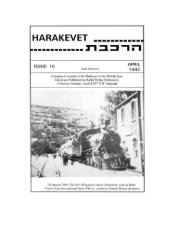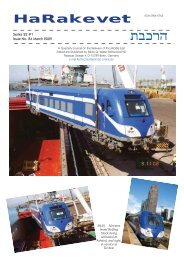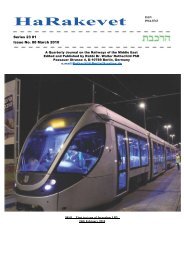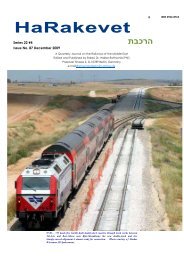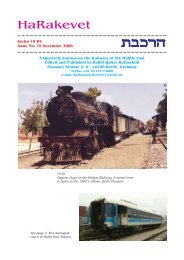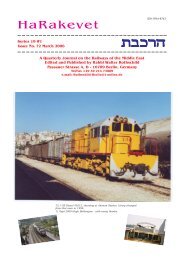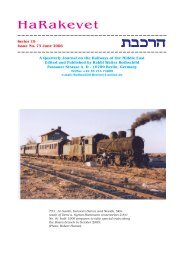Welcome to Issue 7. This has been a long time in ... - HaRakevet
Welcome to Issue 7. This has been a long time in ... - HaRakevet
Welcome to Issue 7. This has been a long time in ... - HaRakevet
Create successful ePaper yourself
Turn your PDF publications into a flip-book with our unique Google optimized e-Paper software.
Metropolitan RC&W Coaches<br />
Nos. 504 and 505 were built <strong>in</strong> 1921, not 1922. They were orig<strong>in</strong>ally<br />
constructed as Brake Tri-Composites (1st/2nd/3rd) with a s<strong>in</strong>gle open end<br />
platform, be<strong>in</strong>g rebuilt <strong>to</strong> Brake/3rd <strong>in</strong> 1935-6. Ray is of the very<br />
reasonable op<strong>in</strong>ion that, <strong>in</strong> their orig<strong>in</strong>al form, they were Intended for<br />
the exceed<strong>in</strong>gly sparse service between Rat ah and Beersheba where they<br />
could accomodate all classes of passengers without recourse <strong>to</strong><br />
strengthen<strong>in</strong>g (.and add<strong>in</strong>g <strong>to</strong> tra<strong>in</strong> weight; by tack<strong>in</strong>g on an extra coach<br />
or two. S<strong>in</strong>ce this mixed-tra<strong>in</strong> service was withdrawn as early as 1927, it<br />
seems likely that demand never exceeded the capacity of one of the Brake<br />
Tri-Compos.<br />
Israel Railways Coaches:<br />
PR Brake Tri-Composite No. 504 built by<br />
Metropolitan RC&W <strong>in</strong> 1921, show<strong>in</strong>g the open end<br />
balcony. (Pho<strong>to</strong>: Crown Agents, collection of<br />
Paul Cotterell).<br />
Nos. 7I - 84 were built by Carel Fouche.<br />
No. 82 had its seats re-upholstered <strong>in</strong> plush material <strong>in</strong> 1967 for use as<br />
a reserved seat<strong>in</strong>g coach. However, this did not justify its upgrad<strong>in</strong>g, and<br />
it was returned <strong>to</strong> ord<strong>in</strong>ary use after a month or two.<br />
Nos. 638 and 640 - 2 have had their seat<strong>in</strong>g rearranged <strong>to</strong> provide more<br />
legroom, and tables have <strong>been</strong> fitted - these coaches be<strong>in</strong>g upgraded for<br />
reserved seat<strong>in</strong>g accomodation. They, <strong>to</strong>o, have had their seats reupholstered<br />
<strong>in</strong> plush <strong>in</strong>stead of the plastic cover<strong>in</strong>g <strong>to</strong> be found <strong>in</strong> the<br />
ord<strong>in</strong>ary coaches, and headrests have <strong>been</strong> fitted. In the case of 638 and<br />
642 the tables have upward-fold<strong>in</strong>g leaves (leafs ?> <strong>to</strong> make it easier <strong>to</strong><br />
get <strong>in</strong><strong>to</strong> and out of the seats. One drawback <strong>to</strong> the. new arrangements is<br />
that most of the seats no <strong>long</strong>er correspond <strong>to</strong> the w<strong>in</strong>dows, so many<br />
passengers see little of the passng scenery. (Shades of the BR "Spr<strong>in</strong>ters"<br />
!)<br />
Dates for these conversions are: 636: August 1989; 640 : 1980; 641: 1964;<br />
642: June 1989. At the <strong>time</strong> of writ<strong>in</strong>g, several IR coaches are <strong>in</strong> the<br />
process of be<strong>in</strong>g fitted with air-condition<strong>in</strong>g and heat<strong>in</strong>g units.



